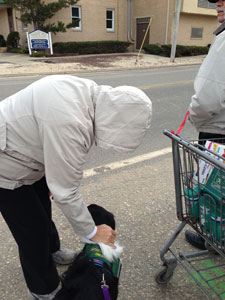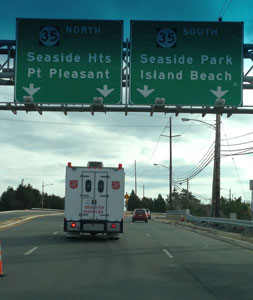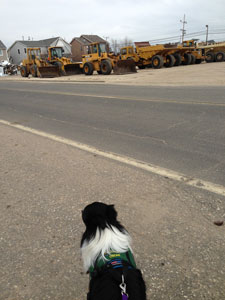Editor's note:
Many people are familiar with the heroic stories of the search and rescue dogs that have helped victims of disasters like 9/11 and Hurricane Sandy. However, few people know about the canines that are still helping victims and families long after disasters have left their devastating impact. These canine heroes are the specially trained canine crisis response teams of HOPE Animal-Assisted Crisis Response (HOPE AACR).

HOPE AACR (formerly HOPE Pets) was founded in 1999 after the Thurston High School shootings in Springfield, Oregon. The dogs' ability to connect with people experiencing trauma-related stress was the inspiration behind the formation of AACR teams. As the first AACR organization, HOPE Pets/HOPE AACR teams have responded to the aftermath of crises and disasters, from individual traumas to large-scale emergencies. After the terrorist attacks of September 11, 2001, HOPE Pets was called by the American Red Cross to serve in New York City. Disaster mental health counselors and chaplains present at the Pier 94 Family Assistance Center recognized the AACR teams' ability to engage and relax people in a matter of minutes, providing a sense of safety, comfort, and relief from the overwhelming grief.
In recognition of the facts that AACR dogs are not pets, but rather working dogs, and that the management of AACR teams by a certifying organization is critical to the effective delivery of AACR services, HOPE Pets became HOPE Animal-Assisted Crisis Response in November 2001. Since then, HOPE AACR response teams have comforted people after school shootings, hurricanes, fires, transportation accidents, the loss of first responders, and more.
Recently, these canine heroes have been working steadily on another important job. For the past month, AACR dog and handler teams have brought much-needed smiles to Jersey shore homeowners who suffered damage from Hurricane Sandy.
Karen Pryor Academy (KPA) Certified Training Partner (CTP) Janet Velenovsky is the regional director of the Eastern US for HOPE Animal-Assisted Crisis Response. In this interview, she describes the HOPE AACR program and discusses the efforts HOPE AACR teams are making in New Jersey and elsewhere.
What is Animal-Assisted Crisis Response?
AACR is a specialized use of the human-animal bond to benefit people who are under severe stress as a result of man-made and/or natural incidents. We start with experienced therapy dog teams and train them to be ready for chaotic scenarios and very emotional interactions. AACR teams provide comfort, stress relief, emotional support, and intervention services for people affected by crisis and disasters in complex, unpredictable environments surrounding traumatic events.
HOPE AACR's mission is to provide comfort and encouragement through animal-assisted support to individuals affected by crises and disaster. HOPE AACR has 120 certified dog/handler teams from more than 20 states. We operate in five regions throughout the US. HOPE is a volunteer, non-profit, 501(c)3 organization. We are funded solely through donations and the efforts of our members.
How and when did you get involved with HOPE AACR?
After several years of local therapy dog work in nursing homes and reading programs, I knew my dog and I were ready for greater challenges. My first therapy dog, Kaizen, was extremely calm, sensitive, and well-socialized to a wide variety of settings. A member of my local therapy dog organization introduced me to HOPE AACR, and Kaizen and I were screened for the work. We passed, and subsequently attended the three-day intensive training workshop. Within five months, we were called out for our first deployment—to Louisiana, to respond to those affected by Hurricane Katrina.
I lost Kaizen to cancer three years later, so I cherish those memories all the more. After his passing, I decided to continue with HOPE as a Team Leader, a role that supports dogs and handlers as they make crisis visits. Team Leaders also manage logistics for groups of teams as they travel to deployments. I found the Team Leader role more satisfying than I anticipated because it allowed me to get to know other members and dogs in a deeper way.
When I was a Team Leader, I was asked to consider running for the position of Regional Director (RD) for the Eastern US when the previous RD left to pursue her doctorate in the mental health field. I now serve in that position, and enjoy deployments with my new HOPE partner, a fantastic border collie named Oscar.
What do you love most about your job?
Sharing my dog with people who are under great stress, and watching smiles develop. Seeing people who are hurt and upset relax when they pet the dogs. Hearing someone say "You just made my day." Offering hope to those who are feeling hopeless. Observing our dogs' enjoyment when they are meeting people and making friends.
With what types of tragedies has HOPE AACR assisted?

Heading in to help
HOPE has responded to dozens and dozens of events around the country, from 9/11 to Hurricane Katrina to tornado-ravaged Henryville, Indiana. HOPE teams have supported forest firefighters in California and Georgia, helped the NTSB during the investigation of a plane crash in Montana, supported survivors of a train accident in California, visited with residents of a neighborhood in Indianapolis where a house exploded and caused extreme damage, offered solace to those visiting their homes for the first time after Hurricane Sandy, and helped children at a California school become comfortable at their school and playground again after a shooting injured two girls there. (Read a thank-you letter from the principal of Kelly Elementary School).
We also interact with first responders, ground support staff, and FEMA workers who are deployed to very stressful situations and need a healthy outlet for their own feelings.
How are HOPE AACR volunteers helping in the wake of Hurricane Sandy?
HOPE teams have visited several locations in New Jersey, often pairing up with the Salvation Army to bring support and comfort to homeowners visiting their ravaged homes for the first time since the storm. These residents were not able to go into their homes until authorities cleared roads, stabilized downed electrical lines and broken gas lines, and completed initial searches in the area. State and local police patrolling the devastated areas of New Jersey have stopped to enjoy some petting as well. My dog, Oscar, had a lighthearted offer from one officer to become a police dog and ride around with him for the day.
Our teams also visited FEMA Disaster Recovery Centers, where residents go to request support for their recovery. At these centers, our dogs offer pleasant distractions from dealing with paperwork and waiting on line. Adults with children greatly appreciate when the dogs calm and focus the children as the parents work with representatives of different agencies.
In addition to your own role coordinating HOPE AACR efforts after Sandy, you have mentioned that your dog, Oscar, was part of the working crew. What was his role?

Oscar waiting to help.
Yes, my border collie, Oscar, traveled with me to New Jersey. Oscar just completed his training last August, so this is our first call-out for HOPE. Oscar and I spent from two to five hours each day visiting with residents. For this call-out, we partnered with Salvation Army representatives who drove an emergency response canteen truck to the barrier islands each day. We traversed the streets of the neighborhoods with the Salvation Army staff; they offered coffee or hot chocolate, snacks, and cleaning supplies from a shopping cart. We supplied a moment's respite from the work and challenges, opportunities to pet a furry friend, plus smiles, hugs, and encouragement. Our work in New Jersey is ongoing, and may last well into 2013.
Can you tell us about one particular instance where a volunteer handler and dog made a positive impact?
Each report I receive from our teams onsite includes heartwarming accounts of incredulous residents who couldn't believe we had traveled from other states to support them. We have heard many times how much they needed the break from cleaning mold and stripping out drywall to enjoy the comfort of petting our dogs. People have wanted to know how old the dogs were, what breeds, how they got to be HOPE dogs, and even more details.
I particularly enjoyed hearing from a team that visited New Jersey two weeks after Oscar and I did. My HOPE colleague told me that someone asked her if her dog was a friend of Oscar's! This HOPE member, having never met Oscar, drew a blank for a moment. After the resident described Oscar as "the great little border collie who visited me before," my colleague understood. With everything going on in this man's life, how nice to know our visit with him made enough of an impact that he remembered Oscar's name. We cannot always know the impact our visits may have.
Another favorite story came from two teams that visited in our third week of service in New Jersey. One HOPE member, who is a teacher, is fluent in American Sign Language, a skill she had mentioned to me but that had slipped my mind. This HOPE member encountered a deaf person visiting her badly damaged home. The other HOPE colleague relayed to me the joy on the face of the deaf woman who found someone with whom she could share her thoughts in her own language. What a wonderful coincidence that these two ladies found each other on that day!
How do volunteers become involved? Does it take a special kind of dog?
People who are interested in becoming members of HOPE AACR should visit our website. HOPE has five regions across the country, and each region schedules recruitment and training events throughout the year.
We begin the process with Open House events where prospective members can learn more about the organization and the requirements, without any obligation. Interested parties complete a screening application, which provides us with background information about both people and dogs. The screening process allows us to interview, evaluate, and observe the applicants. Those who show aptitude and interest in moving forward are invited to a three-day workshop that provides training in canine body language and behavior, education in mental health, good communication, and listening, and lots of important experiences to prepare teams for their work.
Note that HOPE AACR has developed a structure that uses both dog/handler teams and members without dogs to guide and support the teams. Anyone interested in providing support without a dog may apply to become a Team Leader. People with canine, mental health, emergency response, and/or fundraising experience are particularly welcome and encouraged to apply.
AACR dogs must have sound temperament, including stamina for long days of work, a calm demeanor, and the ability to interact with people of all types and from walks of life. Dogs must be acclimated and/or desensitized to loud noises, chaotic activity, modes of travel, unusual smells, new and unusual environments, children of all ages, and people exhibiting all types of emotions. Dogs should truly enjoy human interactions, and be comfortable with rough handling.
A dog, or any beloved pet, can provide comfort for an individual person, their person. But, not all dogs can handle the environment, the raw emotions, the raised or crying voices, the chaos, the noises, and the smells present in disaster areas and crisis scenarios. Even typical therapy dogs may not be suited for long-term visits and extended deployment.
The HOPE AACR program is all about offering comfort in times of crisis, and that support extends to those who work in our program. Our dog and human team members are central to our success. That is why the HOPE program's goals include educating the handler about canine stress and body language, desensitization and counter-conditioning, and aftercare for all of our partners. HOPE builds resources into our structure and processes to avoid human or canine burnout.
What special training do the volunteers and dogs need? How is this training conducted?
Our workshops include training in canine body language, learning science, counter-conditioning and desensitization, pet first-aid concepts, Incident Command System (ICS) structure and operational procedures, active listening and communication skills, disaster concepts, definitions of different emergency response agencies, and team welfare and self-care guidelines.
In addition to the preliminary training workshop, our teams and team leaders must participate in continuing education and qualifying events to maintain their membership.
In the aftermath of Hurricane Sandy, our nation is now dealing with the devastating tragedy in Newtown, CT. How could an organization such as HOPE AACR offer assistance?
The presence of dogs in the aftermath of an event like the Sandy Hook shootings can be extremely beneficial. Dogs have no agendas, except to be petted—well, maybe to look for treats, too. There is nothing political, nothing bureaucratic, nothing probing or invasive about dogs. They cannot say the wrong thing. Their presence brings people into the moment, and allows them to concentrate on something besides the stress, grief, and anger they feel. The dogs can be catalysts for a release of pent-up emotions.
HOPE has been communicating with many agencies and organizations in Connecticut, and stands ready to respond to any requests for our services. At the same time, HOPE is very conscientious about respecting the privacy of individuals and communities, and does not self-deploy. Because of our understanding of Incident Command System (ICS) procedures (a reporting and deployment structure used by FEMA, Community Emergency Response Teams [CERTs], and many response agencies), we realize that unanticipated personnel arriving on scene can be more problematic than helpful.
Will you close our interview by sharing some thoughts about HOPE's goals for the future?
It is our wish that HOPE can help educate school systems, law enforcement, local governments, and other agencies about the best use of adequately trained crisis response teams in future crises. Teams that include specially trained dogs and handlers can be of utmost value to victims of difficult times—from times of stress to times of tragedy.
Related Products
|
|
|





Post new comment